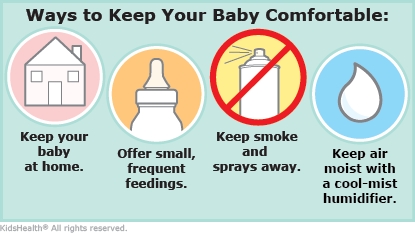Whooping Cough (Pertussis): How to Care for Your Child
Whooping cough (pertussis) can be a serious illness in young children. Your child is doing well and can go home.


Whooping cough is a contagious illness caused by bacteria. Kids with this illness often get severe coughing spells that can last more than a minute. Sometimes kids with pertussis cough so hard that red spots from broken blood vessels happen in one or both eyes.
Young infants may choke or stop breathing instead of coughing, so they often need care in the hospital to make sure they can breathe normally. Infants with pertussis sometimes have a hard time drinking enough and might get dehydrated. Also, some children with whooping cough develop pneumonia and need special care.
In the hospital, your child received an antibiotic to treat the infection. The medical team closely watched your child's breathing for any problems, as some kids need to get extra oxygen. The care team also made sure that your child was eating enough and getting enough fluids.
It is now safe for your child to go home. Even after the infection has cleared, mild coughing may continue for several weeks, but should steadily improve.

-
Give your child all the doses of antibiotics, even if your child is feeling better.
-
Your child should stay home until the health care provider says it's OK.
-
If your child still has a cough:
-
Using a cool-mist humidifier in your child's bedroom might make your child more comfortable. Clean the humidifier every day to prevent mold growth.
-
Do not give cough medicine. It does not help whooping cough and is not safe for children younger than 6.
-
Give your child plenty of liquids to drink.
-
If your child is throwing up, offer small, frequent feedings.
-
Keep your home free of irritants, such as smoke and aerosol sprays, that can trigger coughing spells.

-
Schedule any follow-up appointments as directed.
-
Make sure your family's pertussis vaccinations are up to date.
-
To prevent the spread of infection, teach your kids to wash their hands often and to cough or sneeze into a shirtsleeve or tissue (not their hands).
-
Whooping cough is very contagious. Members of your household and other people that your child spends time with (such as kids and caretakers at school or childcare) should visit the health care provider for possible antibiotic treatment to prevent them from getting sick and for testing if they are already sick.

Your child:

Your child:
-
Looks blue or purple when coughing.
-
Has trouble breathing or seems to have brief periods of not breathing.
-
Appears dehydrated; signs include dizziness, drowsiness, a dry or sticky mouth, sunken eyes or soft spot on the head, crying with few or no tears, or peeing less often (or having fewer wet diapers).
-
Has a seizure.